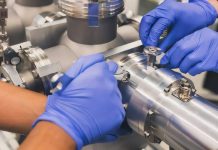
Immunotherapy is a modern medical marvel, but it doesn’t always work as well as we hope, especially in treating advanced breast cancers.
In fact, over 80% of such cases remain untreatable with current immunotherapy.
Even for patients who do respond, the threat of the cancer spreading—known as metastasis—is often still present.
However, groundbreaking research from Stanford University and the Arc Institute is shining new light on how we might improve these odds.
At the heart of this research is a protein named ENPP1, discovered by Lingyin Li, an associate professor of biochemistry at Stanford and a researcher at the Arc Institute.
ENPP1 is like a switch that controls whether breast cancer resists immunotherapy and whether it can spread to other parts of the body. The findings were published on December 20 in the Proceedings of the National Academy of Sciences.
The team noticed something critical: both cancer cells and normal cells near the tumor produce ENPP1. And, patients with high levels of ENPP1 in their bodies often don’t respond well to immunotherapy, and they’re more likely to experience cancer spread.
This discovery could pave the way for new and more effective immunotherapies. It might also help doctors predict how well patients will respond to existing treatments. Li, who is passionate about this work, believes their study brings hope to many.
The challenge in treating cancer with immunotherapy lies in how the immune system interacts with tumors. Some tumors, like those in melanoma and certain lung cancers, are ‘hot’—they’re full of immune cells and respond well to immunotherapy.
Others, like breast and pancreatic cancers, are ‘cold’ and have few immune cells to fight the cancer. Li’s mission is to find ways to turn these cold tumors hot.
Her journey began with a molecule called cGAMP, which is produced when a cell’s DNA is damaged, like in cancer.
cGAMP can kickstart an immune response through the STING pathway, potentially turning a cold tumor hot. But here’s the catch: ENPP1 destroys cGAMP before it can do its job, keeping the tumor cold.
ENPP1 isn’t just a one-trick pony; it does various things in the body. So, Li and her colleagues, including Hani Goodarzi and Laura Van’t Veer, wanted to know if ENPP1’s ability to break down cGAMP was the key to its role in cancer.
They turned to data from breast cancer patients in the I-SPY 2 Trial, looking at how their responses to pembrolizumab, an immunotherapy drug, varied with their ENPP1 levels at diagnosis. The results were striking.
Patients with high ENPP1 levels had poor responses to the drug and a higher chance of metastasis. In contrast, those with low ENPP1 levels responded well to the treatment and did not experience metastasis.
Two insights emerged: ENPP1 is vital not only in primary tumors but also in metastases, and it’s important to look at ENPP1 in healthy cells, not just cancer cells.
Songnan Wang, a biochemistry student and researcher at Arc, was thrilled to delve deeper. In mouse studies, the team found that removing ENPP1 or just stopping its cGAMP-breaking action led to less tumor growth and fewer metastases. This was all due to the STING pathway being unleashed.
Li likens immune pathways to waterfalls. For a cancer to evade the immune system, it needs to build dams to stop the flow of signals. ENPP1 acts as a major dam at the very top of this waterfall.
The implication is profound. ENPP1 levels could help doctors choose the best treatment for breast cancer patients. Drugs targeting ENPP1 could enhance existing therapies, and some are already being developed.
Li’s research, while focused on breast cancer, could have implications for other cold tumors, like lung cancer, glioblastoma, and pancreatic cancer. She hopes her work will inspire other researchers and clinicians to explore ENPP1’s role in various cancers.
If you care about cancer, please see recent studies about new way to increase the longevity of cancer survivors, and results showing new way to supercharge cancer-fighting T cells.
For more information about health, please see recent studies about how drinking milk affects risks of heart disease and cancer and results showing that vitamin D supplements could strongly reduce cancer death.
The research findings can be found in PNAS.
Copyright © 2023 Knowridge Science Report. All rights reserved.



